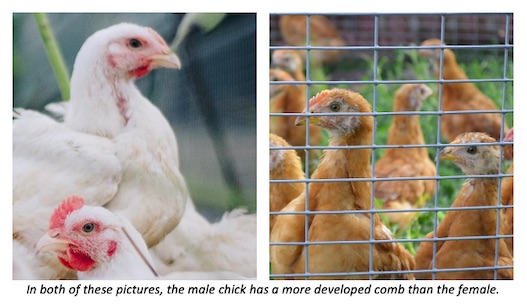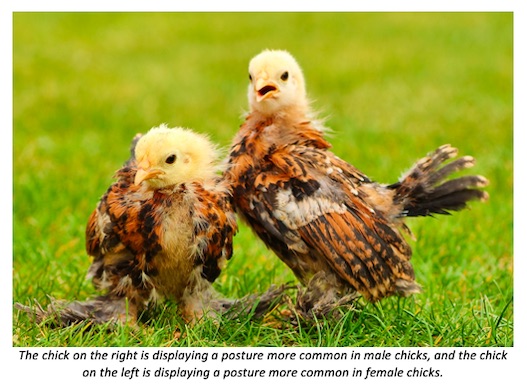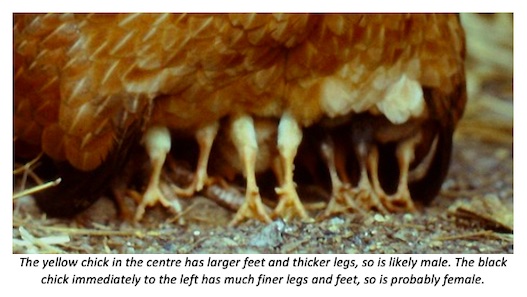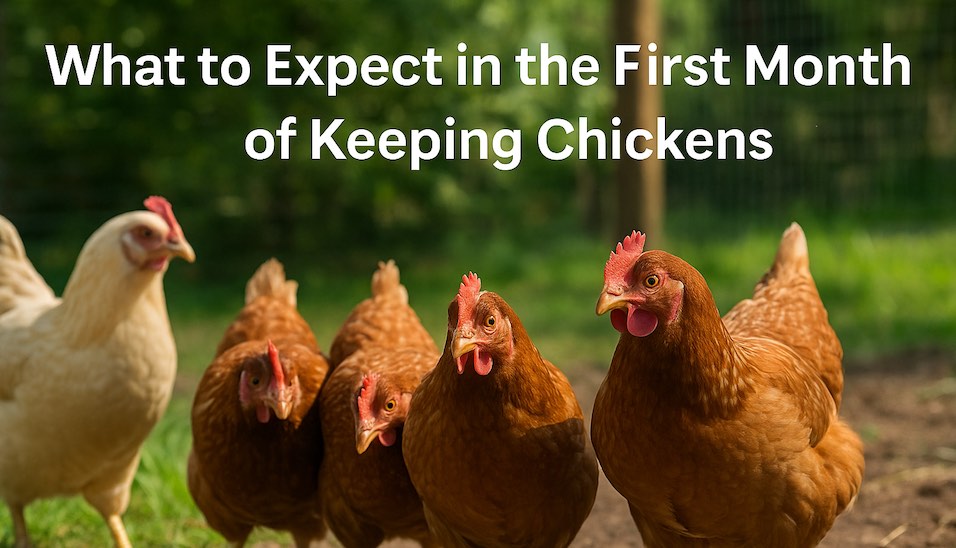Sexing Chicks - How to tell if a chick is male or female
Sexing Chicken Chicks At Home
For most backyard chicken keepers, the sex of their birds is important. After all, many people choose to keep only hens.
So when you buy or hatch chicks, how can you tell the sex?
How early can you tell the sex of chicks?
There is no reliable method of sexing chicken eggs before you incubate them. But there are some unreliable methods that it can’t hurt to try, which we detail below.
Scientists can determine the sex of the chick in an egg before it hatches, but unfortunately this technology is not available to backyard chicken keepers in Australia.
Sex can be determined in newly hatched chicks by vent sexing, but this shouldn't be tried at home as it can cause death or permanent injury to the chick if done incorrectly. In autosexing and sex-link chicken breeds, sex can be determined immediately due to colour or feather patterns.
But if you don't have sex-link or autosexing chickens, you will have to wait until chicks are at least 3 weeks old to try to guess their sex. For most chicken keepers, sex can be reliably picked from about 10-12 weeks, depending on breed.
How to sex chicken chicks
Like everything, telling whether a chick is male or female is something that gets easier with experience. Practicing with just one breed and marking chicks so you can see whether your prediction was correct can help you improve.
Here are some methods of chick sexing that you can use at home.
How accurate is chick sexing?
Even if you are just guessing, there is a 50 % chance that you will correctly identify the sex of a chick.
Most chick sexing methods are more accurate than tossing a coin, but even vent sexing professionals are only 90 % accurate. So unless you have sex-link or autosexing chicken breeds, be prepared for some mistakes!
Reliable sexing techniques to use at home
The most reliable methods of sexing young chicks at home depend on having an autosexing or sex-link chicken breed. Otherwise, you are limited to paying for a DNA test or waiting for your chicks to grow up enough to be able to identify sex accurately.
Autosexing chicken chicks
Autosexing chickens are heritage breeds that show clear colour markings based on sex at hatch. Sometimes male and female chicks are different colours or shades or they may have different feather markings.
Some autosexing chicken breeds include:
- Rhode Island Reds
- New Hampshires
- Welsummers
- Barred Plymouth Rocks
- Buckeyes
- Silver Leghorns
- Silver Duckwings
- Legbars
Even in autosexing breeds, it can be difficult to reliably identify the sex of chicks. Differences can be subtle and natural variation between chicks can create confusion. But with practice, autosexing breeds can be sorted into male and female with 90 % accuracy. That's as good as vent sexing!
Sex-link chicken chicks
Sex-link chickens are hybrid breeds, which means the rooster is one breed and the hen is another. Sex-linked chickens use a knowledge of genetics to produce chicks with clearly identifiable characteristics depending on whether they are male or female.
Sex-link chicks are usually easier to sex than autosexing breeds, and result in the most reliable sexing of day-old chicks as male or female. Sex-link chick sexing is even more reliable than professional vent sexing!
Sex-link chicken varieties include:
- Black sex-link, e.g. Black Rocks
- Red sex-link, e.g. ISA Browns, Golden Comets, Cinnamon Queens
- Colour sex-links (silver or gold)
- Feather sex-links (see below)
Some sex-link hybrids can be bred at home, while others, like the ISA Brown, have proprietary genetics and can only be bought.
Because sex-link chickens are hybrids, you cannot get sex-link chicks from a sex-link rooster and hen. You must go back to the original cross and use pure-breed roosters and hens to breed a sex-link chick, for example, a Barred Plymouth Rock hen crossed with a non-barred male.
Feather sexing
It is a myth that male and female chicks can be identified by their wing feathers. Only sex-link chickens selected for feathering can be identified by feather sexing.
Wing feather sexing only works when a slow-feathering rooster is bred with a fast-feathering hen. In this case, female chicks will feather more quickly than male chicks, and the females will have covert feathers that are shorter than their primary feathers. Feather sexing must take place by examining the wings before chicks are 3 days old.
DNA sexing
If you really don't want to wait for your chicks to grow up a little, vets can usually arrange a DNA test that will determine whether a chick is male or female by testing blood or feathers.
Sexing pullets and cockerels
Most chicken keepers wait until their chicks have reached 10-12 weeks, also known as pullet stage, before they attempt to determine their sex. By the time they are pullets (female) and cockerels (male), chicks have begun to display characteristics that indicate sex.
The most reliable way to sex chicks at 10-12 weeks is to look for at least 3 characteristics of one sex or the other. This will help you avoid mistakes!
Sexing chickens is easier when you can compare chicks of the same age and breed. And some birds are just harder to sex than others, in which case you might just have to wait for an egg or a crow!
Here are 5 easy signs to identify the sex of a chicken
1. Comb and wattles
Roosters have a bigger comb than hens. In some breeds, combs can begin to develop from 3 weeks onward, making them a great tool for identifying sex in fairly young chicks. However, other breeds may not develop a comb until as late as 6 months!
Typically, male chicks will develop their comb earlier than female chicks. Males will also have a larger and redder comb than females.
If you are using combs to determine the sex of chicks, it is most helpful to look when combs first start developing, as the differences between male and female combs tend to decrease as the combs develop, before becoming noticeable again as adults.

In some breeds, such as Silkies, comb shape can also be an indication of sex, with males having a more U-shaped comb when it first develops and females having a more V-shaped comb.
Wattles, the lobes which hang from a chicken’s throat, are also larger on roosters and can provide an early indication of sex in some breeds.
2. Behaviour
Roosters and hens behave differently, and many chicks will start showing sex-based behaviour as early as a week old!
Male chicks are often more confident and aggressive. They may fight with each other, usually by chest bumping and trying to stand over one another, or react aggressively to sudden movement or new objects. They may also have a more upright pasture than females.
Female chicks tend to be more submissive. In particular, they may begin to crouch down and hold their wings out slightly if you try to pick them up. This is a clear sign of a hen.

3. Feet and legs
Roosters have bigger feet and legs than hens, and this size difference usually starts developing early. Look for thicker legs and toes, and bigger feet, from about 6 weeks.

Also, the roosters of some breeds have spurs on the back of their legs. Spurs can develop early, starting out as a small bump or bud on the back of the leg. But some breeds don't have spurs, and others don't develop spurs until 5-6 months.
4. Crowing
Crowing, of course, is a pretty good indicator that you have a rooster. And cockerels will begin to practice crowing at around 16 weeks, sometimes early.
But it is important not to rely on crowing alone to identify a rooster for two reasons. Firstly, some hens will try to crow, particularly in a flock without a rooster. And secondly, where there are multiple roosters it is not uncommon for the less dominant roosters to refrain from crowing at all.
5. Feathers
Looking at wing feathers is only useful for sexing sex-link chicken breeds. But overall feather development can indicate whether a chick is a male or female.
From 8 weeks old, depending on breed, mature feathers will start developing. Roosters typically have longer, pointier feathers around the base of the neck (hackles) and lower back (saddle). Their tail feathers will also be more uneven compared to hens.
Other chicken sexing techniques you can try
It is important to note that these chick sexing techniques are not proven to be accurate. But if you are hatching your own eggs, there is no harm in trying to predict sex!
Identifying the sex of eggs before you incubate them
It isn’t possible to accurately identify the sex of the chick that would hatch from an egg before the egg is incubated. If it were, the commercial egg industry would be doing it!
But there are two promising techniques for sexing chicken eggs. Neither is scientifically proven, but if you are hatching your own eggs, even a slight increase in the ratio of hens to roosters might make them worth trying!
There is an old wives’ tale that rounder eggs are more likely to produce female chicks, while “male” eggs are more pointed or oval. A scientific study published last year suggests that this may be true. The study used egg shape to accurately determine the sex of about 80 % of chicks, but shape was measured using mathematic parameters, not just eye-balling the egg. Further testing is needed to prove that the method is reliable, and both breed and hen age might influence reliability.
Another method of determining egg sex can be found in a book published by the American Poultry School in 1921. This method relies on candling the eggs and some compelling evidence of the method’s accuracy is provided in the book. Whether this method would work with a different breed or in a different environment is unclear. But if you do want to have a go, the book is available in full here and the instructions for candling begin on page 31.
Sexing chicken eggs before they hatch
It is possible to determine the sex of a chick before it hatches. But unfortunately, determining the sex of a chick in the egg relies on expensive scientific techniques such as bio-marker detection and spectroscopy, which are not available to backyard chicken keepers in Australia.
Some old wives’ tales suggest that using a pendulum, such as a needle or a gold ring on a string, can reveal the sex of the chick in an egg. The pendulum is supposed to swing in a circle if the chick is female and from side to side if the chick is male. But this method is probably no more reliable than guessing.
Old chicken keepers where I live also swear that chickens that sit on eggs in winter or early spring will hatch more female chicks than chickens that sit on eggs in the summer.
Chick sexing techniques you shouldn’t try at home
Some of the chick sexing methods that exist should not be used at home, especially vent sexing.
Vent sexing chicks
Vent sexing involves looking inside the cloaca to identify whether a chick is male or female. It can be used with newly hatched chicks. However, you should never try vent sexing at home unless you have had extensive, in-person training from an expert. Watching a YouTube clip or reading a few How-To articles is not enough.
Vent sexing can kill chicks if done incorrectly. It can also cause disembowelment or permanent injury.
Also, it is hard to tell the difference between male and female cloaca so the results of vent sexing are only about 90 % accurate even for experts. If you just watched a video or two, you won't be any more accurate than some of the other, safer methods we have already discussed. So why risk the chick's life and health?
Holding chicks
Some sources state that when you hold chicks upside down, male chicks will struggle to right themselves and female chicks won’t. However, chicks can find this test distressing and as it doesn’t work anyway, it should be avoided.
Another method is holding chicks with their legs dangling. Some sources say the male chicks will try to draw their legs up, while others say the females will. Not only is this method of chicken sexing unreliable, chicks are more comfortable if held with their feet supported. If you are trying to raise well-adjusted, friendly chickens, then holding chicks so they are comfortable is important!
What to do if you really don’t want roosters
Ultimately, the best way to ensure you don’t end up the accidental owner of a rooster is to buy point-of-lay or adult hens. Older pullets can often also be reliably sexed, depending on the breed and experience of the breeder.
If you are purchasing day-old chicks, sex-link and autosexing breeds tend to be more reliable than other sexed day-old chicks. This is because vent sexing is only about 90 % accurate. You can also look for a hatchery that offers returns or replacements for incorrectly sexed chicks.
Happy chicken keeping!
Rachael at Dine a Chook Australia







